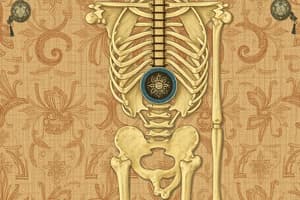Podcast
Questions and Answers
In a third-class lever, the external weight always has greater leverage than the muscle force.
In a third-class lever, the external weight always has greater leverage than the muscle force.
False (B)
Third-class levers are the least common type of lever in the musculoskeletal system.
Third-class levers are the least common type of lever in the musculoskeletal system.
False (B)
Third-class levers provide high forces that can be used to stabilize the joint effectively.
Third-class levers provide high forces that can be used to stabilize the joint effectively.
False (B)
In a third-class lever, the mechanical advantage is always greater than 1.
In a third-class lever, the mechanical advantage is always greater than 1.
Vector resolution is the process of replacing two or more forces with a single force that is equivalent to the original forces.
Vector resolution is the process of replacing two or more forces with a single force that is equivalent to the original forces.
The rotatory component in a third-class lever acts parallel to a bony segment.
The rotatory component in a third-class lever acts parallel to a bony segment.
The translatory component in a third-class lever compresses and stabilizes the joint.
The translatory component in a third-class lever compresses and stabilizes the joint.
A free body diagram includes forces like Sy, Wx, and S.
A free body diagram includes forces like Sy, Wx, and S.
Musculoskeletal forces applied to the body can only cause translation of a body segment.
Musculoskeletal forces applied to the body can only cause translation of a body segment.
The moment arm (D) is the shortest distance between the force (F) and the axis of rotation (AoR).
The moment arm (D) is the shortest distance between the force (F) and the axis of rotation (AoR).
Torque (T) is the product of the force (F) and the moment arm (D).
Torque (T) is the product of the force (F) and the moment arm (D).
The internal moment arm (IMA) is the distance between the joint's axis of rotation and the effective site of external force application.
The internal moment arm (IMA) is the distance between the joint's axis of rotation and the effective site of external force application.
The external moment arm (EMA) is the distance between the joint's axis of rotation and the effective internal force.
The external moment arm (EMA) is the distance between the joint's axis of rotation and the effective internal force.
The equation $IF \times D = EF \times D_1$ is always true.
The equation $IF \times D = EF \times D_1$ is always true.
The internal torque is always equal to the external torque.
The internal torque is always equal to the external torque.
The majority of human movement is translational, not rotational.
The majority of human movement is translational, not rotational.
In a first-class lever, the axis of rotation is positioned between the opposing forces.
In a first-class lever, the axis of rotation is positioned between the opposing forces.
The head is held in equilibrium when the product of muscle force (MF) and internal moment arm (IMA) equals the product of head weight (HW) and external moment arm (EMA).
The head is held in equilibrium when the product of muscle force (MF) and internal moment arm (IMA) equals the product of head weight (HW) and external moment arm (EMA).
In a first-class lever, the internal and external forces act in the same linear direction.
In a first-class lever, the internal and external forces act in the same linear direction.
The mechanical advantage of the first-class lever example given in the text is 0.8.
The mechanical advantage of the first-class lever example given in the text is 0.8.
In a second-class lever, the axis of rotation is located at one end of a bone.
In a second-class lever, the axis of rotation is located at one end of a bone.
The calf muscles are an example of a second-class lever.
The calf muscles are an example of a second-class lever.
In a second-class lever, the muscle force has less leverage than the external force.
In a second-class lever, the muscle force has less leverage than the external force.
Second-class levers are common in the musculoskeletal system.
Second-class levers are common in the musculoskeletal system.
Flashcards are hidden until you start studying



